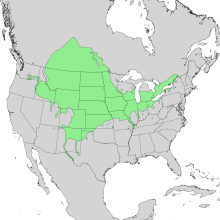Salix amygdaloides
| Salix amygdaloides | |
|---|---|

| |
| Peachleaf willow leaves | |
| Scientific classification | |
| Kingdom: | Plantae |
| Clade: | Tracheophytes |
| Clade: | Angiosperms |
| Clade: | Eudicots |
| Clade: | Rosids |
| Order: | Malpighiales |
| Family: | Salicaceae |
| Genus: | Salix |
| Species: | S. amygdaloides
|
| Binomial name | |
| Salix amygdaloides | |

| |
| Natural range | |
Salix amygdaloides, the almond leaf willow or peach leaf willow, is a species of willow native to central North America east of the Cascade Range.[2] It can be found in southern Canada and the United States—from western British Columbia to Quebec, Idaho, Montana and Arizona to eastern Kentucky.[3] As of 2022, it is presumed extirpated from the state of Kentucky.[4]
It is a small to medium-sized deciduous tree, growing to 4–20 metres (13–66 ft) tall; besides the cottonwoods, it is the largest tree native to the prairies. It has a single trunk, or sometimes several shorter trunks. The leaves are lanceolate, 3–13 centimetres (1+1⁄4–5 in) long and 1–4 cm (1⁄2–1+1⁄2 in) wide, yellowish green with a pale, whitish underside and a finely serrated margin. The flowers are yellow catkins, 3–8 cm (1+1⁄4–3+1⁄4 in) long, produced in the spring with the leaves. The reddish-yellow fruit matures in late spring or early summer, and the individual capsules are 4–6 millimetres (3⁄16–1⁄4 in) long.[5][6]
The peachleaf willow grows very quickly, but is short-lived. It can be found on the northern prairies, often near streams, and accompanying cottonwoods. As the common and scientific names suggest, the leaves bear some similarity to those of a peach and (even more so) of an almond.[2]
References
[edit]- ^ Stritch, L. (2018). "Salix amygdaloides". IUCN Red List of Threatened Species. 2018: e.T126588956A126591015. doi:10.2305/IUCN.UK.2018-2.RLTS.T126588956A126591015.en. Retrieved 11 April 2024.
- ^ a b Arno, Stephen F.; Hammerly, Ramona P. (2020) [1977]. Northwest Trees: Identifying & Understanding the Region's Native Trees (field guide ed.). Seattle: Mountaineers Books. p. 192. ISBN 978-1-68051-329-5. OCLC 1141235469.
- ^ "Salix amygdaloides". Germplasm Resources Information Network. Agricultural Research Service, United States Department of Agriculture.
- ^ Rodgers, Devin; Littlefield, Tara; McDonald, Kendall (2022). "Office of Kentucky Nature Preserves Kentucky Rare Plant List". Frankfort, Kentucky: Energy and Environment Cabinet, Office of Kentucky Nature Preserves.
{{cite journal}}: Cite journal requires|journal=(help) - ^ "Salix amygdaloides". Plants of British Columbia.
- ^ "Salix amygdaloides". Northern Prairie Wildlife Research Center. Archived from the original on 2008-03-28.
External links
[edit] Media related to Salix amygdaloides at Wikimedia Commons
Media related to Salix amygdaloides at Wikimedia Commons Data related to Salix amygdaloides at Wikispecies
Data related to Salix amygdaloides at Wikispecies- "Salix amygdaloides". Plants for a Future.

